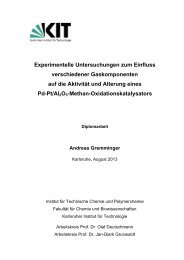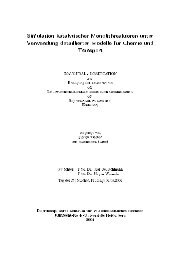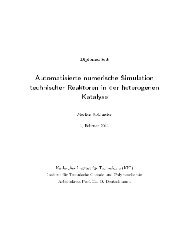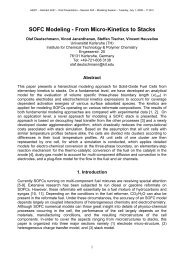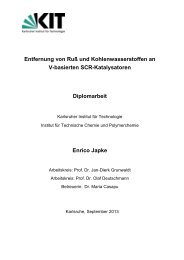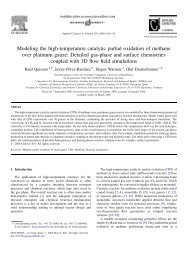Fuel Processing for Fuel Cells - Institut für Technische Chemie und ...
Fuel Processing for Fuel Cells - Institut für Technische Chemie und ...
Fuel Processing for Fuel Cells - Institut für Technische Chemie und ...
Create successful ePaper yourself
Turn your PDF publications into a flip-book with our unique Google optimized e-Paper software.
Author's personal copy<br />
<strong>Fuel</strong> <strong>Processing</strong> <strong>for</strong> <strong>Fuel</strong> <strong>Cells</strong> 27<br />
On the other side, equivalent per<strong>for</strong>mance is observed <strong>for</strong> varying chain<br />
lengths of the hydrocarbon backbone or the appearance of side chains.<br />
Ethylene, propylene, and acetylene are precursors <strong>for</strong> coke <strong>for</strong>mation in<br />
re<strong>for</strong>ming processes (Kang et al., 2010, 2011; Villano et al., 2010). The<br />
propensity of the <strong>for</strong>mation of these coke precursors is also dominated<br />
by the structure of the hydrocarbon fuel (Hartmann et al., 2009a). Acetylene<br />
is exclusively fo<strong>und</strong> in conversion of aromatic hydrocarbons. Furthermore,<br />
acetylene is the only hydrocarbon cracking product <strong>for</strong>med<br />
<strong>und</strong>er fuel lean conditions, which can be attributed to the high reaction<br />
temperatures reached in conversion of aromatic hydrocarbon fuels and by<br />
an excess of oxygen. The strong increase in <strong>for</strong>mation of a-olefins with<br />
increasing C/O in CPOX of hydrocarbons can also be employed <strong>for</strong><br />
application in chemical industry (Krummenacher and Schmidt, 2004).<br />
Based upon the knowledge of the reaction of characteristic fuel constituents,<br />
surrogates of logistic fuels can be obtained. Besides the reduction<br />
of the high complexity of commercial fuels in model fuels, the use of<br />
surrogates allows a reliable standardization and reproduction of CPOX<br />
experiments. Moreover, the influence and interaction of dominant constituents<br />
can be explored, allowing the development of detailed models<br />
<strong>for</strong> CPOX of logistic fuels.<br />
Gasoline/ethanol mixtures: The characteristic features of ethanol re<strong>for</strong>ming<br />
lead to the question of their impact on the re<strong>for</strong>ming of gasoline that is<br />
blended with ethanol. The increasing use of renewable fuels, <strong>for</strong> example,<br />
ethanol, and fossil fuels blended with renewable fuels, <strong>for</strong> example, E10,<br />
in vehicles also intensifies the research activities <strong>for</strong> these fuels in the field<br />
of on-board hydrogen supply (Cavallaro et al., 2003a; de Lima et al., 2009;<br />
Deluga et al., 2004; Fatsikostas et al., 2002; Hebben et al., 2010; Hohn and<br />
Lin, 2009; Kirillov et al., 2008; Liguras et al., 2004; Ni et al., 2007; Nilsson<br />
et al., 2008; Sato et al., 2010). In a recent study, Diehm (2010) systematically<br />
studied the impact of ethanol content in gasoline on CPOX of gasoline<br />
over a Rh/alumina-coated monolith. Using ethanol/i-octane as surrogate,<br />
it was observed that the conversion of ethanol is faster than that<br />
of iso-octane (Figure 7). In particular, the conversion of iso-octane<br />
already drops at relatively low C/O ratios, and increasing ethanol content<br />
intensifies this effect. The hydrogen selectivity generally decreases<br />
with increasing ethanol content; however, this trend is not linear. In fact,<br />
the highest hydrogen yield is achieved at 5% ethanol and not at pure isooctane<br />
(Figure 7). The <strong>for</strong>mation of by-products is also promoted by<br />
ethanol, and rather high ethylene concentrations are fo<strong>und</strong> even at low<br />
C/O ratios. All these findings were also observed using ethanol blended<br />
with commercial gasoline (E5, E10, E85) (Diehm, 2010), which implies<br />
that ethanol-blended iso-octane can serve as a surrogate <strong>for</strong> ethanolblended<br />
gasoline.



